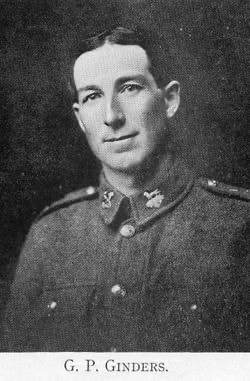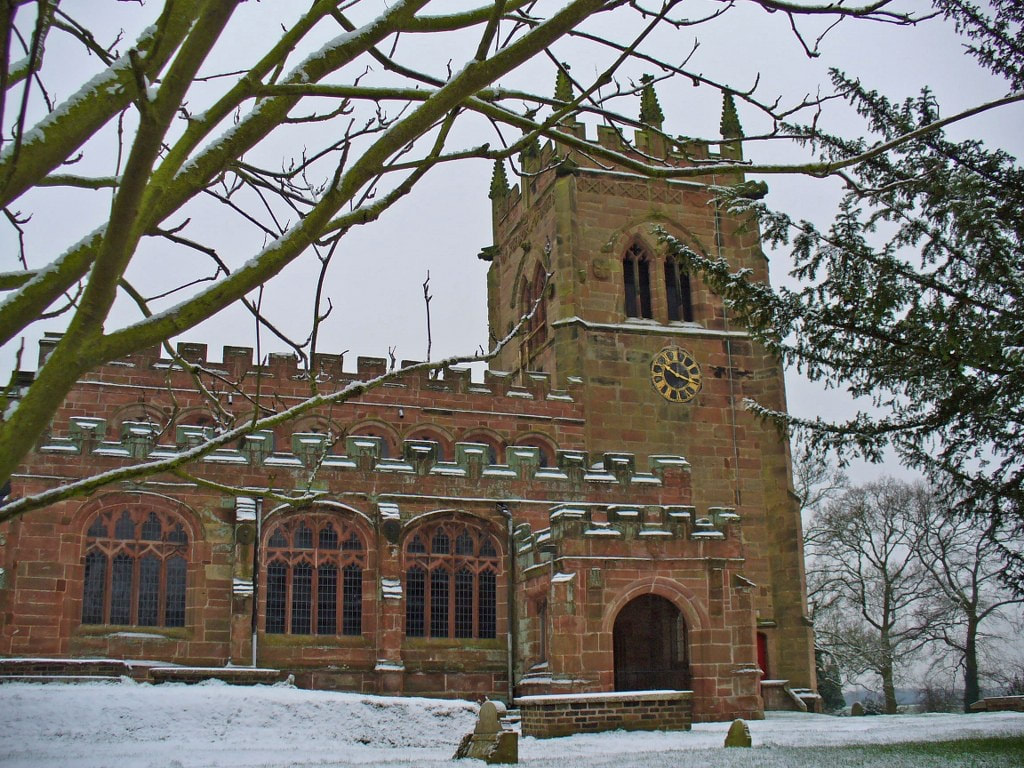BARTHOMLEY (ST. BERTOLINE) CHURCHYARD
Cheshire
England
GPS Coordinates: Latitude: 53.06807, Longitude: -2.34873
Location Information
Barthomley is a small village in Cheshire, England. The Churchyard is located in the centre of the village.

51716 Private
George Percy Ginders
Canterbury Regiment, N.Z.E.F.
15th March 1918, aged 28.
Son of Thomas and Annie Ginders, of Pear Tree Lake Farm, Balterley, Crewe, England.
The information below supplied by 'The Ellesmerian Club', the alumni organisation for Ellesmere College where George was a pupil.
George Percy Ginders
Canterbury Regiment, N.Z.E.F.
15th March 1918, aged 28.
Son of Thomas and Annie Ginders, of Pear Tree Lake Farm, Balterley, Crewe, England.
The information below supplied by 'The Ellesmerian Club', the alumni organisation for Ellesmere College where George was a pupil.
George Percy Ginders, who was born in Church Eaton, Staffordshire on 9th April 1889, was one of the six sons of Thomas and Annie Ginders, farmers, latterly of Pear Tree Lake, Batterley, Crewe. By 1896, the family lived at West Hill Farm, Appleby Magna, Leicestershire and George attended the Church of England School there from 13th July 1896. He left in September 1901 to attend the local grammar school but, with the family moving to Crewe he was only a pupil there for one year.
He was the only son to attend Ellesmere College and was admitted in September 1902.He was allocated to the ‘Heywood’ dormitory although his stay there was for only about fifteen months as he left in December 1903. In this short time he represented his dormitory in cricket and rugby. Records of the time are sparse and it is not known which career path he followed when he left Ellesmere, but the Census of 1911 recorded his occupation as a farm labourer.
Some twenty months later he was a passenger, along with his younger brother Harry, on the ss Corinthia. They embarked in London on 5th December 1912 bound for a new life in New Zealand – following in the footsteps of their elder brother, who had already emigrated there. On arrival in their adopted land, George established himself in the farming community and was gainfully employed. It would appear that the other brothers, John, Thomas and Arthur, along with their sister, remained in England.
When the war broke out thousands of New Zealanders volunteered to fight but, on 1st August 1916, the authorities introduced conscription. By the end of the war, approximately 124,000 men (nearly half the eligible male population of the entire country) had served with the New Zealand Expeditionary Force. Of these, over 100,000 served overseas and George was one of them.
George enlisted and signed his Attestation Papers on 7th March 1917. He passed the medical examination which recorded he weighed 154 pounds (70 kg) and was 5 foot 10 inches tall (1.75m). He was deemed fully fit and healthy and joined ‘A’ Company as Private Ginders, Service No. 51716 to commence his basic training with the Canterbury Regiment. On completion, he was posted to the 27th Reinforcements, ‘F’ Company. He enjoyed his final leave and returned to Hawarden where a social gathering was held at which he was presented with a shaving kit. There was, according to one newspaper report dancing….kept up until an early hour of the morning. He embarked on the ss Athenic at Wellington, New Zealand on 16th July 1917 along with the 19th Reinforcements, Maori Contingent.
Exactly two months later, their long voyage came to an end when they disembarked at Liverpool. They immediately headed for Sling, a training camp near Salisbury, where they were posted until they departed for France on 26th October 1917.
Within days of his arrival in Europe, George marched to Étaples, but towards the end of November he was hospitalised suffering from German measles. He recovered and, in January 1918, was in Abbeville but by the end of the month he was hospitalised again suffering from trench fever. He was evacuated to England in the middle of February and died a month later, twenty-eight years old, from the complications of tubercular meningitis.
George was buried in the family grave at Barthomley (St. Bertoline) Churchyard in Cheshire. His life is commemorated, along with his brother Joseph who died in Turkey in 1915, on a plaque inside the church.
He was the only son to attend Ellesmere College and was admitted in September 1902.He was allocated to the ‘Heywood’ dormitory although his stay there was for only about fifteen months as he left in December 1903. In this short time he represented his dormitory in cricket and rugby. Records of the time are sparse and it is not known which career path he followed when he left Ellesmere, but the Census of 1911 recorded his occupation as a farm labourer.
Some twenty months later he was a passenger, along with his younger brother Harry, on the ss Corinthia. They embarked in London on 5th December 1912 bound for a new life in New Zealand – following in the footsteps of their elder brother, who had already emigrated there. On arrival in their adopted land, George established himself in the farming community and was gainfully employed. It would appear that the other brothers, John, Thomas and Arthur, along with their sister, remained in England.
When the war broke out thousands of New Zealanders volunteered to fight but, on 1st August 1916, the authorities introduced conscription. By the end of the war, approximately 124,000 men (nearly half the eligible male population of the entire country) had served with the New Zealand Expeditionary Force. Of these, over 100,000 served overseas and George was one of them.
George enlisted and signed his Attestation Papers on 7th March 1917. He passed the medical examination which recorded he weighed 154 pounds (70 kg) and was 5 foot 10 inches tall (1.75m). He was deemed fully fit and healthy and joined ‘A’ Company as Private Ginders, Service No. 51716 to commence his basic training with the Canterbury Regiment. On completion, he was posted to the 27th Reinforcements, ‘F’ Company. He enjoyed his final leave and returned to Hawarden where a social gathering was held at which he was presented with a shaving kit. There was, according to one newspaper report dancing….kept up until an early hour of the morning. He embarked on the ss Athenic at Wellington, New Zealand on 16th July 1917 along with the 19th Reinforcements, Maori Contingent.
Exactly two months later, their long voyage came to an end when they disembarked at Liverpool. They immediately headed for Sling, a training camp near Salisbury, where they were posted until they departed for France on 26th October 1917.
Within days of his arrival in Europe, George marched to Étaples, but towards the end of November he was hospitalised suffering from German measles. He recovered and, in January 1918, was in Abbeville but by the end of the month he was hospitalised again suffering from trench fever. He was evacuated to England in the middle of February and died a month later, twenty-eight years old, from the complications of tubercular meningitis.
George was buried in the family grave at Barthomley (St. Bertoline) Churchyard in Cheshire. His life is commemorated, along with his brother Joseph who died in Turkey in 1915, on a plaque inside the church.





